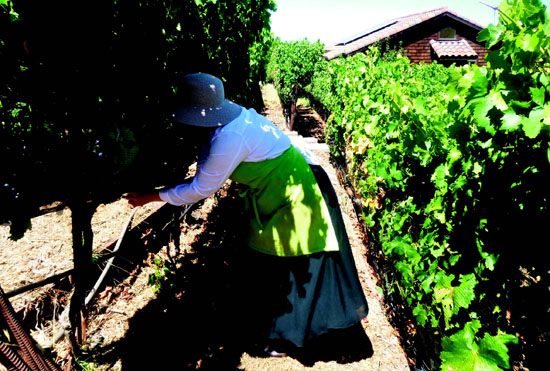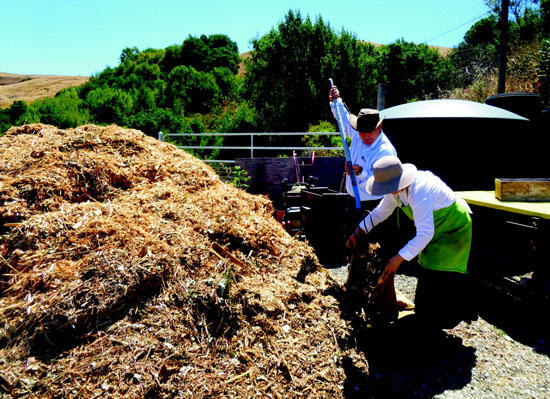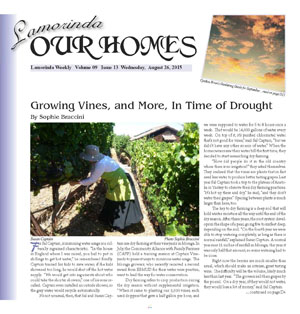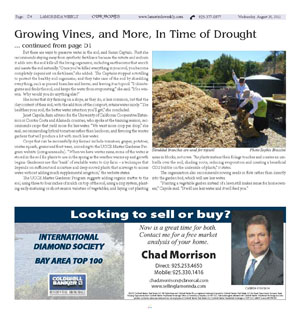|
|
Published August 26th, 2015
|
Growing Vines, and More, In Time of Drought
|
|
| By Sophie Braccini |
 |
| Susan Captain- Photo Sophie Braccini |
For Sal Captain, minimizing water usage is a culturally ingrained characteristic. "In the house in England where I was raised, you had to put in shillings to get hot water," he remembered fondly. Captain trained his kids to save water; if the kids showered too long, he would shut off the hot water supply. "We would get into arguments about who could take the shorter showers," one of his sons recalled. Captain even installed an outside shower, so the gray water would recycle automatically.
 It's not unusual, then, that Sal and Susan Captain use dry farming at their vineyards in Moraga. In July, the Community Alliance with Family Farmers (CAFF) held a training session at Captain Vineyards to present ways to minimize water usage. The Moraga growers, who recently received a second award from EBMUD for their water-wise practice, want to lead the way for water conservation.
It's not unusual, then, that Sal and Susan Captain use dry farming at their vineyards in Moraga. In July, the Community Alliance with Family Farmers (CAFF) held a training session at Captain Vineyards to present ways to minimize water usage. The Moraga growers, who recently received a second award from EBMUD for their water-wise practice, want to lead the way for water conservation.
 Dry farming refers to crop production during the dry season without supplemental irrigation. "When it came to planting our 3,500 vines, each used drippers that gave a half gallon per hour, and we were supposed to water for 6 to 8 hours once a week. That would be 14,000 gallons of water every week. On top of it, it's purified chlorinated water that's not good for vines," said Sal Captain, "but we didn't have any other source of water." When the homeowners saw their water bill the first time, they decided to start researching dry farming.
Dry farming refers to crop production during the dry season without supplemental irrigation. "When it came to planting our 3,500 vines, each used drippers that gave a half gallon per hour, and we were supposed to water for 6 to 8 hours once a week. That would be 14,000 gallons of water every week. On top of it, it's purified chlorinated water that's not good for vines," said Sal Captain, "but we didn't have any other source of water." When the homeowners saw their water bill the first time, they decided to start researching dry farming.
 "How did people do it in the old country where there is no irrigation?" they asked themselves. They realized that the vines are plants that in fact need less water to produce better tasting grapes. Last year Sal Captain took a trip to the plateau of Anatolia in Turkey to observe their dry farming practices. "It's hot up there and dry," he said, "and they don't water their grapes." Spacing between plants is much larger than here, too.
"How did people do it in the old country where there is no irrigation?" they asked themselves. They realized that the vines are plants that in fact need less water to produce better tasting grapes. Last year Sal Captain took a trip to the plateau of Anatolia in Turkey to observe their dry farming practices. "It's hot up there and dry," he said, "and they don't water their grapes." Spacing between plants is much larger than here, too.
 The key to dry farming is a deep soil that will hold winter moisture all the way until the end of the dry season. After three years, the root system develops in the shape of a pear, going five to six feet deep, depending on the soil. "On the fourth year we were able to stop watering completely, as long as there is normal rainfall," explained Susan Captain. A normal year sees 15 inches of rainfall in Moraga; this year it was only half that amount, so some watering had to be done.
The key to dry farming is a deep soil that will hold winter moisture all the way until the end of the dry season. After three years, the root system develops in the shape of a pear, going five to six feet deep, depending on the soil. "On the fourth year we were able to stop watering completely, as long as there is normal rainfall," explained Susan Captain. A normal year sees 15 inches of rainfall in Moraga; this year it was only half that amount, so some watering had to be done.
 Right now the berries are much smaller than usual, which should make an intense, great tasting wine. The difficulty will be the volume, likely much less than last year. "The growers sell their grapes by the pound. On a dry year, if they would not water, they would lose a lot of money," said Sal Captain.
Right now the berries are much smaller than usual, which should make an intense, great tasting wine. The difficulty will be the volume, likely much less than last year. "The growers sell their grapes by the pound. On a dry year, if they would not water, they would lose a lot of money," said Sal Captain.
 But there are ways to preserve water in the soil, said Susan Captain. First she recommends staying away from synthetic fertilizers because the nitrate and sodium it adds into the soil kills all the living organisms, including earthworms that enrich and aerate the soil naturally. "Once you've killed everything in your soil, you become completely dependent on fertilizers," she added. The Captains stopped rototilling to protect the healthy soil organisms, and they take care of the soil by shredding everything, such as pruned branches and leaves, and leaving it as topsoil. "It disintegrates and feeds the soil, and keeps the water from evaporating," she said. "It's a win-win. Why would you do anything else?"
But there are ways to preserve water in the soil, said Susan Captain. First she recommends staying away from synthetic fertilizers because the nitrate and sodium it adds into the soil kills all the living organisms, including earthworms that enrich and aerate the soil naturally. "Once you've killed everything in your soil, you become completely dependent on fertilizers," she added. The Captains stopped rototilling to protect the healthy soil organisms, and they take care of the soil by shredding everything, such as pruned branches and leaves, and leaving it as topsoil. "It disintegrates and feeds the soil, and keeps the water from evaporating," she said. "It's a win-win. Why would you do anything else?"
 She notes that dry farming on a slope, as they do, is less common, but that the clay content of their soil, with the addition of the compost, retains water nicely. "The healthier your soil, the better water retention you'll get," she concluded.
She notes that dry farming on a slope, as they do, is less common, but that the clay content of their soil, with the addition of the compost, retains water nicely. "The healthier your soil, the better water retention you'll get," she concluded.
 Janet Caprile, farm advisor for the University of California Cooperative Extension in Contra Costa and Alameda counties, who spoke at the training session, recommends crops that yield more for less water. "We want more crop per drop," she said, recommending hybrid tomatoes rather than heirloom, and favoring the winter gardens that will produce a lot with much less water.
Janet Caprile, farm advisor for the University of California Cooperative Extension in Contra Costa and Alameda counties, who spoke at the training session, recommends crops that yield more for less water. "We want more crop per drop," she said, recommending hybrid tomatoes rather than heirloom, and favoring the winter gardens that will produce a lot with much less water.
 Crops that can be successfully dry farmed include tomatoes, grapes, potatoes, winter squash, grains and fruit trees, according to the UCCE Master Gardener Program website (ccmg.ucanr.edu). "When we have winter rains, some of the water is stored in the soil for plants to use in the spring as the weather warms up and growth begins. Gardeners use this 'bank' of available water to dry farm - a technique that depends on sufficient soil moisture and deep-rooted plants that scavenge to access water without adding much supplemental irrigation," the website states.
Crops that can be successfully dry farmed include tomatoes, grapes, potatoes, winter squash, grains and fruit trees, according to the UCCE Master Gardener Program website (ccmg.ucanr.edu). "When we have winter rains, some of the water is stored in the soil for plants to use in the spring as the weather warms up and growth begins. Gardeners use this 'bank' of available water to dry farm - a technique that depends on sufficient soil moisture and deep-rooted plants that scavenge to access water without adding much supplemental irrigation," the website states.
 The UCCE Master Gardener Program suggests adding organic matter to the soil, using three to four inches of mulch on top of the soil, using a drip system, planting early-maturing or short-season varieties of vegetables, and laying out planting areas in blocks, not rows. "As plants mature their foliage touches and creates an umbrella over the soil, shading roots, reducing evaporation and creating a beneficial CO2 bubble on the underside of plants," it states.
The UCCE Master Gardener Program suggests adding organic matter to the soil, using three to four inches of mulch on top of the soil, using a drip system, planting early-maturing or short-season varieties of vegetables, and laying out planting areas in blocks, not rows. "As plants mature their foliage touches and creates an umbrella over the soil, shading roots, reducing evaporation and creating a beneficial CO2 bubble on the underside of plants," it states.
 The organization also recommends sowing seeds in flats rather than directly into the garden bed, which will use less water.
The organization also recommends sowing seeds in flats rather than directly into the garden bed, which will use less water.
 "Planting a vegetable garden instead of a lawn still makes sense for homeowners," Caprile said. "It will use less water and it will feed you."
"Planting a vegetable garden instead of a lawn still makes sense for homeowners," Caprile said. "It will use less water and it will feed you."

|
 |
| Shredded branches are used for topsoil Photo Sophie Braccini |
|
|
|
|
|
|
| |
|
|
|
|






